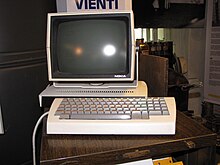History[edit]
1865–1967[edit]
Nokia's history dates from 1865, when Finnish-Swede mining engineer Fredrik Idestam established a pulp mill on the shores of the Tammerkoski rapids near the town of Tampere, Finland (then in the Russian Empire).[5] A second pulp mill was opened in 1868 near the neighboring town of Nokia, where there were better hydropower resources.[5] In 1871, Idestam, together with a friend Leo Mechelin, formed a shared company and called it Nokia Ab (in Swedish, Nokia Company being the English equivalent), after the site of the second pulp mill.
Idestam retired in 1896, making Mechelin the company's chairman; he expanded into electricity generation by 1902, which Idestam had opposed. In 1904 Suomen Gummitehdas (Finnish Rubber Works), a rubber business founded by Eduard Polón, established a factory near the town of Nokia and used its name.
In 1922, in a now independent Finland, Nokia Ab entered into a partnership with Finnish Rubber Works and Kaapelitehdas (the Cable Factory), all now jointly under the leadership of Polón. The rubber company grew rapidly when it moved to the Nokia region in the 1930s to take advantage of the electricity supply, and the cable company soon did too.
Nokia at the time also made respirators for both civilian and military use, from the 1930s well into the early 1990s.[29]
1967–1990[edit]
In 1967, the three companies – Nokia, Kaapelitehdas, and Finnish Rubber Works – merged to create a new Nokia Corporation, restructured into four major businesses: forestry, cable, rubber, and electronics. In the early 1970s, it entered the networking and radio industries. Nokia started making military equipment for Finland's defence forces (Puolustusvoimat), such as the Sanomalaite M/90 communicator in 1983, and the M61 gas mask first developed in the 1960s. Nokia was now also making professional mobile radios, telephone switches, capacitors and chemicals.
After Finland's trade agreement with the Soviet Union in the 1960s, Nokia expanded into the Soviet market. It soon widened trade, ranging from automatic telephone exchanges to robotics among others; by the late 1970s, the Soviet Union became a major market for Nokia, yielding high profits. Nokia also co-operated on scientific technology with the Soviet Union. The U.S. government became increasingly suspicious of that co-operation after the end of the Cold War détente in the early 1980s. Nokia imported many US-made components and used them in products for the Soviets, and according to U.S. Deputy Minister of Defence, Richard Perle, Nokia had a secret co-operation with The Pentagon that allowed the U.S. to keep track of technological developments in the Soviet Union through trading with Nokia.[30] This was a demonstration of Finland trading with both sides, as it was neutral during the Cold War.
In 1977, Kari Kairamo became CEO and transformed the company's businesses. By this time, Finland was becoming what has been called "Nordic Japan".[by whom?] Under his leadership, Nokia acquired many companies including television maker Salora in 1984, followed by Swedish electronics and computer maker Luxor AB in 1985, and French television maker Oceanic in 1987. This made Nokia the third-largest television manufacturer of Europe (behind Philips and Thomson). The existing brands continued to be used until the end of the television business in 1996.
In 1987, Nokia acquired Schaub-Lorenz, the consumer operations of Germany's Standard Elektrik Lorenz (SEL), which included its "Schaub-Lorenz" and "Graetz" brands. It was originally part of American conglomerate International Telephone & Telegraph (ITT), and after the acquisition products were sold under the "ITT Nokia" brand, despite SEL's sale to Compagnie Générale d'Electricité (CGE), the predecessor of Alcatel, in 1986.
On 1 April 1988, Nokia bought the Information Systems division of Ericsson,[31] which had originated as the Datasaab computer division of Swedish aircraft and car manufacturer Saab. Ericsson Information Systems made Alfaskop terminals, typewriters, minicomputers and Ericsson-branded IBM compatible PCs. The merger with Nokia's Information Systems division—which since 1981 had a line of personal computers called MikroMikko—resulted in the name Nokia Data.
Nokia also acquired Mobira, a mobile telephony company, which was the foundation of its future mobile phone business. In 1981, Mobira launched the Nordic Mobile Telephone (NMT) service, the world's first international cellular network and the first to allow international roaming. In 1982, Mobira launched the Mobira Senator car phone, Nokia's first mobile phone. At that time, the company had no interest in producing mobile phones, which the executive board regarded as akin to James Bond's gadgets: improbably futuristic and niche devices. After all these acquisitions, Nokia's revenue base became US$2.7 billion.
CEO Kairamo committed suicide on 11 December 1988.
In 1987, Kaapelitehdas discontinued production of cables at its Helsinki factory after 44 years, effectively shutting down the sub-company.
You received this message because you are subscribed to the Google Groups "1TopReadys1" group.
To unsubscribe from this group and stop receiving emails from it, send an email to 1topreadys1+unsubscribe@googlegroups.com.
To view this discussion on the web visit https://groups.google.com/d/msgid/1topreadys1/CAForgrRACK5pT5wLhS6mp_tuM5HOYqzaYSELKjZnQfN%2BbWdm6w%40mail.gmail.com.











No comments:
Post a Comment